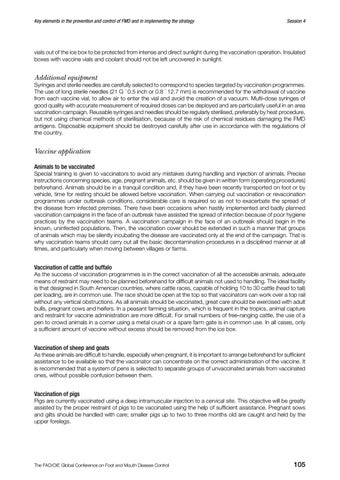Key elements in the prevention and control of FMD and in implementing the strategy
Session 4
vials out of the ice box to be protected from intense and direct sunlight during the vaccination operation. Insulated boxes with vaccine vials and coolant should not be left uncovered in sunlight.
Additional equipment Syringes and sterile needles are carefully selected to correspond to species targeted by vaccination programmes. The use of long sterile needles (21 G ´ 0.5 inch or 0.8 ´ 12.7 mm) is recommended for the withdrawal of vaccine from each vaccine vial, to allow air to enter the vial and avoid the creation of a vacuum. Multi-dose syringes of good quality with accurate measurement of required doses can be deployed and are particularly useful in an area vaccination campaign. Reusable syringes and needles should be regularly sterilised, preferably by heat procedure, but not using chemical methods of sterilisation, because of the risk of chemical residues damaging the FMD antigens. Disposable equipment should be destroyed carefully after use in accordance with the regulations of the country.
Vaccine application Animals to be vaccinated Special training is given to vaccinators to avoid any mistakes during handling and injection of animals. Precise instructions concerning species, age, pregnant animals, etc. should be given in written form (operating procedures) beforehand. Animals should be in a tranquil condition and, if they have been recently transported on foot or by vehicle, time for resting should be allowed before vaccination. When carrying out vaccination or revaccination programmes under outbreak conditions, considerable care is required so as not to exacerbate the spread of the disease from infected premises. There have been occasions when hastily implemented and badly planned vaccination campaigns in the face of an outbreak have assisted the spread of infection because of poor hygiene practices by the vaccination teams. A vaccination campaign in the face of an outbreak should begin in the known, uninfected populations. Then, the vaccination cover should be extended in such a manner that groups of animals which may be silently incubating the disease are vaccinated only at the end of the campaign. That is why vaccination teams should carry out all the basic decontamination procedures in a disciplined manner at all times, and particularly when moving between villages or farms.
Vaccination of cattle and buffalo As the success of vaccination programmes is in the correct vaccination of all the accessible animals, adequate means of restraint may need to be planned beforehand for difficult animals not used to handling. The ideal facility is that designed in South American countries, where cattle races, capable of holding 10 to 30 cattle (head to tail) per loading, are in common use. The race should be open at the top so that vaccinators can work over a top rail without any vertical obstructions. As all animals should be vaccinated, great care should be exercised with adult bulls, pregnant cows and heifers. In a peasant farming situation, which is frequent in the tropics, animal capture and restraint for vaccine administration are more difficult. For small numbers of free-ranging cattle, the use of a pen to crowd animals in a corner using a metal crush or a spare farm gate is in common use. In all cases, only a sufficient amount of vaccine without excess should be removed from the ice box.
Vaccination of sheep and goats As these animals are difficult to handle, especially when pregnant, it is important to arrange beforehand for sufficient assistance to be available so that the vaccinator can concentrate on the correct administration of the vaccine. It is recommended that a system of pens is selected to separate groups of unvaccinated animals from vaccinated ones, without possible confusion between them.
Vaccination of pigs Pigs are currently vaccinated using a deep intramuscular injection to a cervical site. This objective will be greatly assisted by the proper restraint of pigs to be vaccinated using the help of sufficient assistance. Pregnant sows and gilts should be handled with care; smaller pigs up to two to three months old are caught and held by the upper forelegs.
The FAO/OIE Global Conference on Foot and Mouth Disease Control
105
















